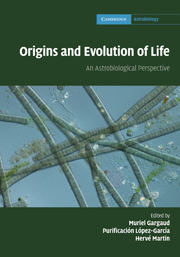Book contents
- Frontmatter
- Contents
- List of contributors
- Foreword
- Preface
- Part I What is life?
- Part II Astronomical and geophysical context of the emergence of life
- Part III The role of water in the emergence of life
- 13 Liquid water: a necessary condition for all forms of life?
- 14 The role of water in the formation and evolution of planets
- 15 Water on Mars
- Part IV From non-living systems to life
- Part V Mechanisms for life evolution
- Part VI Life in extreme conditions
- Part VII Traces of life and biosignatures
- Part VIII Life elsewhere?
- Index
14 - The role of water in the formation and evolution of planets
from Part III - The role of water in the emergence of life
Published online by Cambridge University Press: 04 February 2011
- Frontmatter
- Contents
- List of contributors
- Foreword
- Preface
- Part I What is life?
- Part II Astronomical and geophysical context of the emergence of life
- Part III The role of water in the emergence of life
- 13 Liquid water: a necessary condition for all forms of life?
- 14 The role of water in the formation and evolution of planets
- 15 Water on Mars
- Part IV From non-living systems to life
- Part V Mechanisms for life evolution
- Part VI Life in extreme conditions
- Part VII Traces of life and biosignatures
- Part VIII Life elsewhere?
- Index
Summary
Introduction
Water is known to be ubiquitous in the Universe, from the dark spots of the Sun up to the most distant galaxies. It is also a major component of Solar-System objects, especially in the outer parts beyond heliocentric distances of a few astronomical units (one astronomical unit = AU = average Earth–Sun distance = 149.6 × 106 km). It should be mentioned, however, that the Earth is the only place in the Solar System where water can be present in its three states: solid, liquid and vapour. So far, outside the Earth, water has always been found in the form of vapour or ice, although there are some indications that liquid water might be – or have been – present elsewhere in the Solar System. Liquid water was probably present in the past on the surface of Mars and also possibly Venus; it might currently exist in the interiors of some satellites of giant planets.
The presence of large amounts of water, vapour or ice in the Universe is a natural outcome of the large cosmic abundances of the hydrogen and oxygen elements which form the water molecule. In addition, the large abundance of water in the outer Solar System is also a natural consequence of the formation scenario of the Solar System, which led to the accretion of two classes of planets, the terrestrial and the giant ones, separated by the ‘snow line’, which basically corresponds to the heliocentric distance of water condensation in the primordial solar nebula.
- Type
- Chapter
- Information
- Origins and Evolution of LifeAn Astrobiological Perspective, pp. 218 - 233Publisher: Cambridge University PressPrint publication year: 2011



